SCOUTED: Ligue 1: How to build (and sell) a superstar
.png)
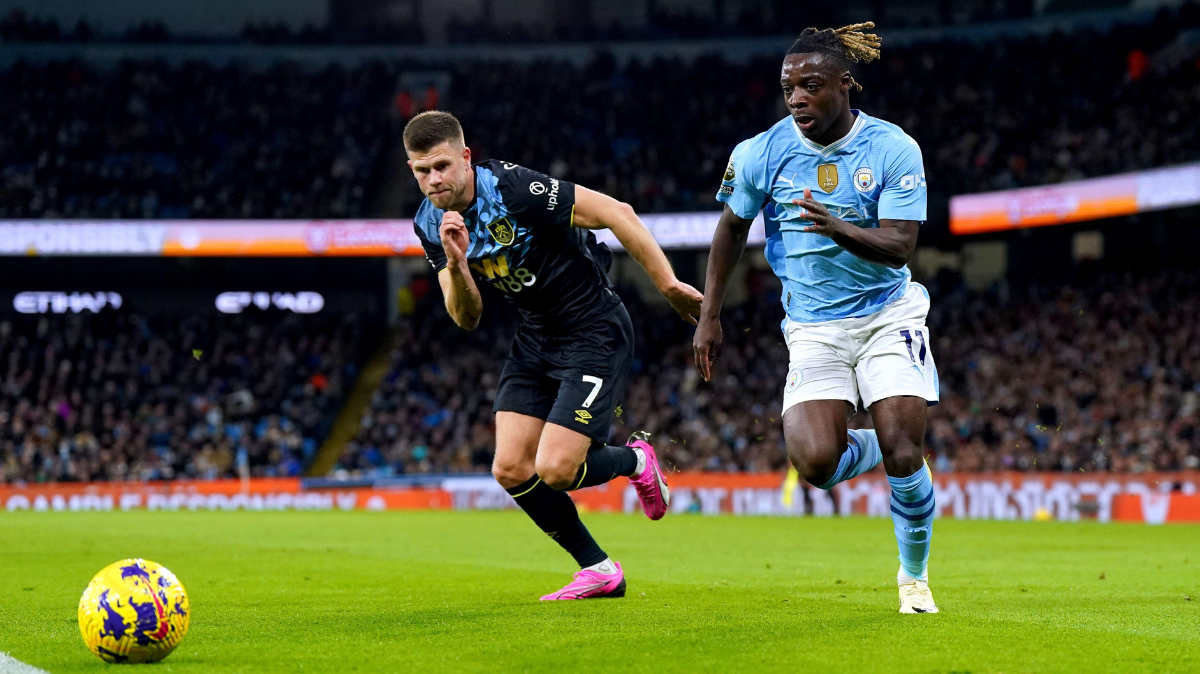
SkillCorner has partnered with Scouted Football, providing data and insights to support their writing on the best emerging talent in football.
In this article, the Scouted team uses Physical and Game Intelligence data to analyse how French Ligue 1 clubs identify and develop players that ultimately make big money moves to the Premier League.
Ligue 1. It’s been the land of milk and honey for Premier League teams looking to sign high-end talent for some time now.
There are currently 28 Frenchmen playing in the Premier League; France is second only to Brazil in the league’s most numerous non-English nationalities, while a huge number of Belgian and African stars often find their pathway to the Premier League including a stopover in France.
In 2022/23, the Ligue 1 frenzy reached a nadir, with 20 players leaving France for England. There were some impressive names in that crew, including Amadou Onana, Benoît Badiashile, Dango Ouattara, Lucas Paquetá, and Sven Botman.
This pipeline is crucial in both directions. The English need good players and the French need the money. With stuttering TV revenues — which lag well behind the other top-five leagues — affecting every club in France not called Paris Saint-Germain, unearthing, developing and selling players is more critical to the league’s continued competitiveness than ever.
So, we’ve set out to answer a couple of key questions.
Firstly: what must French clubs, who are reliant on transfer revenue inflows, do to ensure the pipeline of selling players to Premier League clubs doesn’t run dry?
Then: which current Ligue 1 standouts are prime candidates to head across the Channel in the coming months?
The answers to both will hopefully illustrate how player development and talent identification can be streamlined by Ligue 1 clubs - lest the well run dry.
THE PATHWAYS
Crucially, Ligue 1 clubs have always been innovative both in the ways they promote players from within their own system, but also through their long-established pathways as a logical first step into Europe.
This is especially true for players coming from African countries in which French is widely spoken, such as Senegal, Côte d'Ivoire, Guinea, Mali, Algeria, Morocco, Tunisia, Cameroon, Gabon, the Democratic Republic of Congo, and Burkina Faso. That’s a very strong talent pool.
Perhaps FC Metz best demonstrate how an African-centric strategy can work in practice: the club’s long-standing partnership with Senegal’s Génération Foot has proved fruitful over the last two decades, and helped launch the careers of Papiss Cissé, Diafra Sakho, Sadio Mané, Ismaïla Sarr, and Pape Matar Sarr.
Incredibly, eight members of Metz’s first team this season were signed directly from Génération Foot — and another, Danley Jean Jacques, was plucked from the relative obscurity of Haiti’s Don Bosco FC.
The result for Metz has been a decade of yo-yoing between Ligue 1 and Ligue 2 - not bad going for a club whose total transfer spend in that timespan would be around the €50-60 million mark.
Look up the Ligue 1 table and you’ll find similar, albeit scaled up, strategies everywhere.
For example, LOSC Lille’s proximity to Belgium has meant they are naturally attentive to both top tier Jupiler Pro League talents and Belgian nationals more broadly (they signed Amadou Onana from Hamburg, for instance). LOSC’s prestige, current stature, and selling history allow them to attract players fees in a different ballpark to a club like Metz.
Some of LOSC’s sold-for-profit players include Divock Origi, Kevin Mirallas, Amadou Onana, Victor Osimhen, and of course, Eden Hazard. Incidentally, all bar Osimhen have gone on to play in the Premier League. Current LOSC striker Jonathan David, signed from Genk in 2020, has every chance to someday join them.
Then there are those clubs who prefer to find their players within France’s borders. Olympique Lyonnais, who arguably possess the country’s most dynamic domestic recruitment approaches, scour the entire nation for top prospects to nurture into stars.
OL’s list of success stories in nearly endless: Sidney Govou, Steed Malbranque, Karim Benzema, Loïc Rémy, Hatem Ben Arfa, Maxime Gonalons, Anthony Lopes, Clement Grenier, Alexandre Lacazette, Rachid Ghezzal, Bouna Sarr, Clinton N’Jie, Alassane Plea, Samuel Umtiti, Nabil Fekir, Corentin Tolisso, Anthony Martial, Mouctar Diakhaby, Houssem Aouar, Pierre Kalulu, Melvin Bard, Maxence Caqueret, Amine Gouiri, Castello Lukeba, Bradley Barcola, Malo Gusto, and of course, Rayan Cherki.
The club haven’t always received top-tier fees for what they produce, but few can deny the sheer success of the academy - and its focus on plucking France’s hottest prospects before anyone else.
OPTIMISING THE WORKFLOW
Clearly, many Ligue 1 clubs acquire and develop a huge amount of talent through smartly designed pathways that best utilise their unique identity.
But if they’re looking to produce a Golden Goose, if they want to lab-engineer a player specifically for the Premier League to sell for big cash money, what kind of player should they be aiming for?
With a little help from our friends at SkillCorner, let’s take a closer look.
First things first, let’s start with mythical status of the Premier League as the fastest and most physically intense league in the world: it’s true.
Whether it’s sprints, sprinting distance, PSV-99, or anything else, if it’s a physical metric, it’s probably topped by the Premier League - and often by quite a margin, at least in relation to how clumped together the other top five leagues are.
In contrast, Ligue 1 often finds itself on the other end of the spectrum within Europe’s top five leagues.
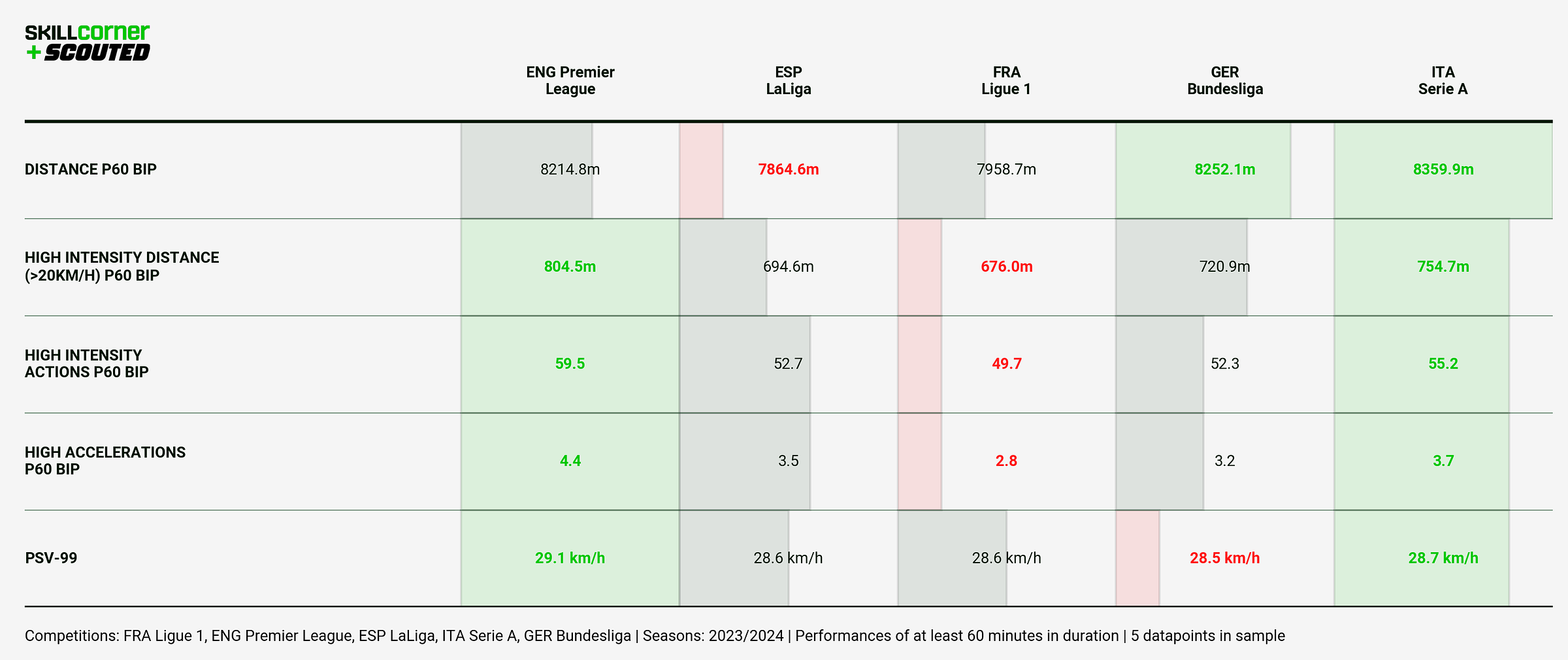
Obviously revamping Ligue 1 from the top down would be difficult. Instead, it’s best considered a physical environment in which athletically gifted players can easily stand out.
If they’re young, mere athletic potential can be enough. For example, Jeremy Doku gave us glimpses of his incredible burst of speed in Ligue 1, despite his other deficiencies and poor injury record.
Here are some of his numbers compared to other Ligue 1 wingers in 2022/23: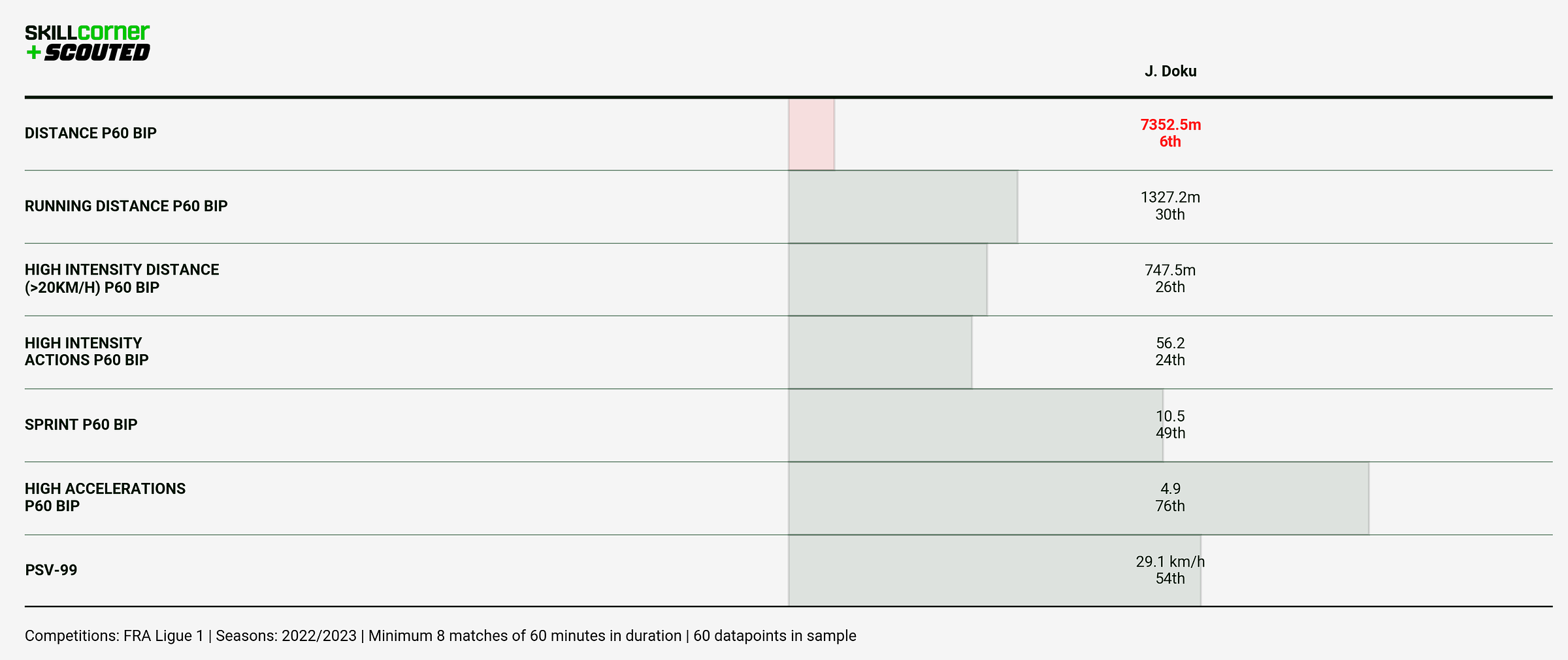
Eyes of course, should wander to that high acceleration number: that’s always been the kicker for Doku.
Interestingly, Doku’s athletic profile produced strikingly similar numbers between 2022/23 at Stade Rennais and 2023/24 with Manchester City. He improved mostly in high accelerations - from 4.9 per 60 BIP to 6.6 per 60 BIP.
Being an all-round athlete is not always the answer. Sometimes, having a specialised type of athletic quality can be most beneficial. For Pep Guardiola and Manchester City, it’s these high accelerations that make Doku incredibly valuable — we’ve all watched him at his best, obliterating defenders with these explosive bursts off the dribble.
It’s also something he has been able to improve upon since joining City.
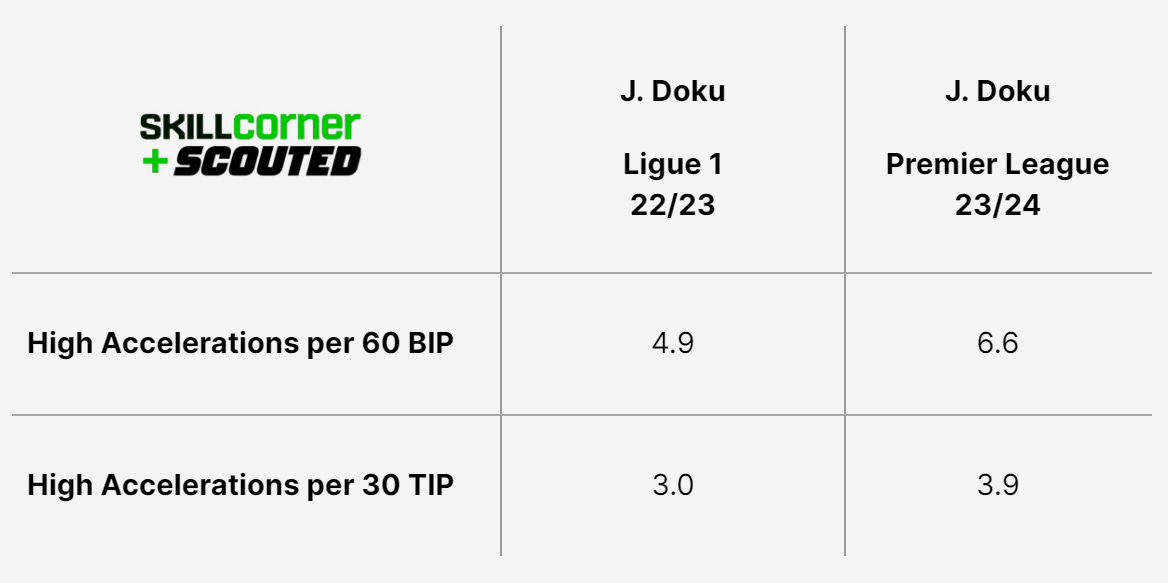
On the other end of the spectrum is a player like Carlos Baleba.
You can bet your life someone at Brighton looked at numbers like this when they decided to spend over €25 million on a player with only 500 Ligue 1 minutes under his belt.
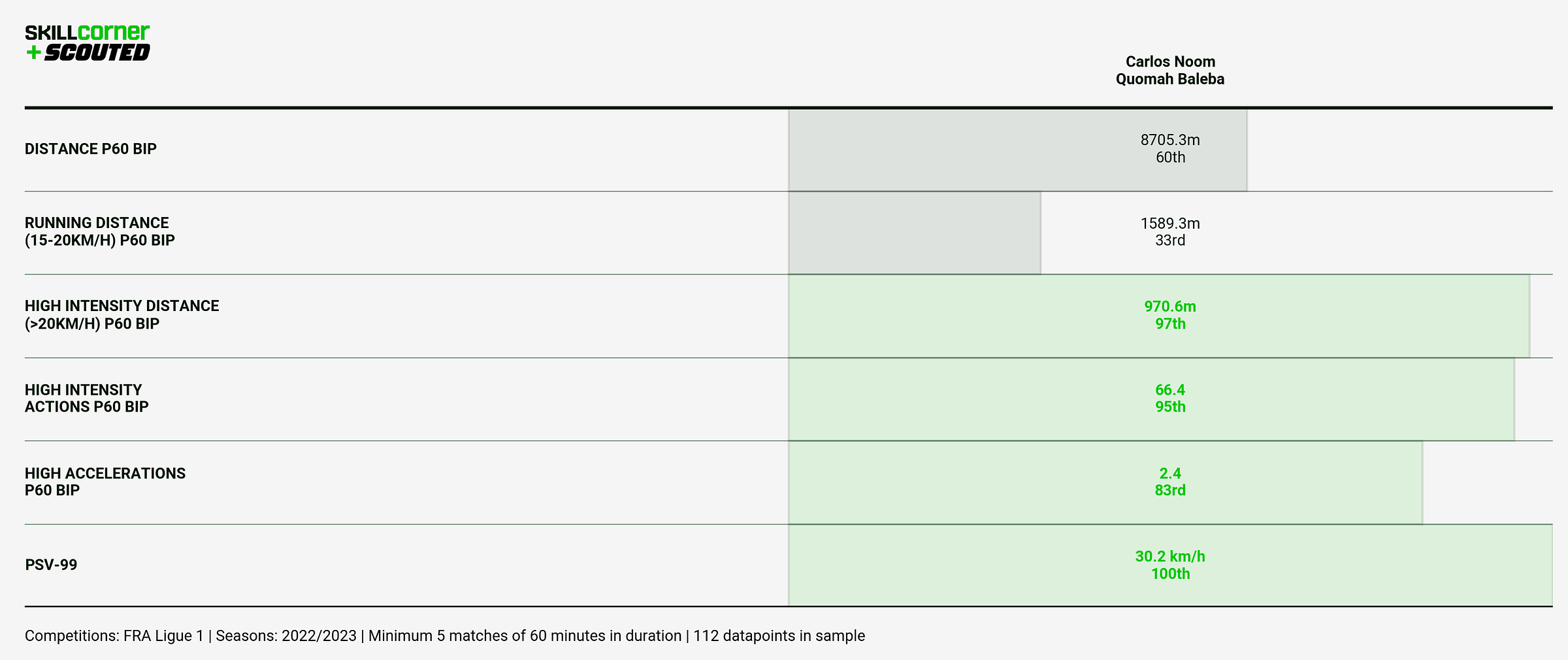
Beware, the sample size above is pretty small — 5+ matches of 60 minutes or more for Ligue 1 midfielders in 2022/23 (he played five) — but it’s still wild.
And in the Premier League this year, his much larger sample size has held extremely closely to that standard.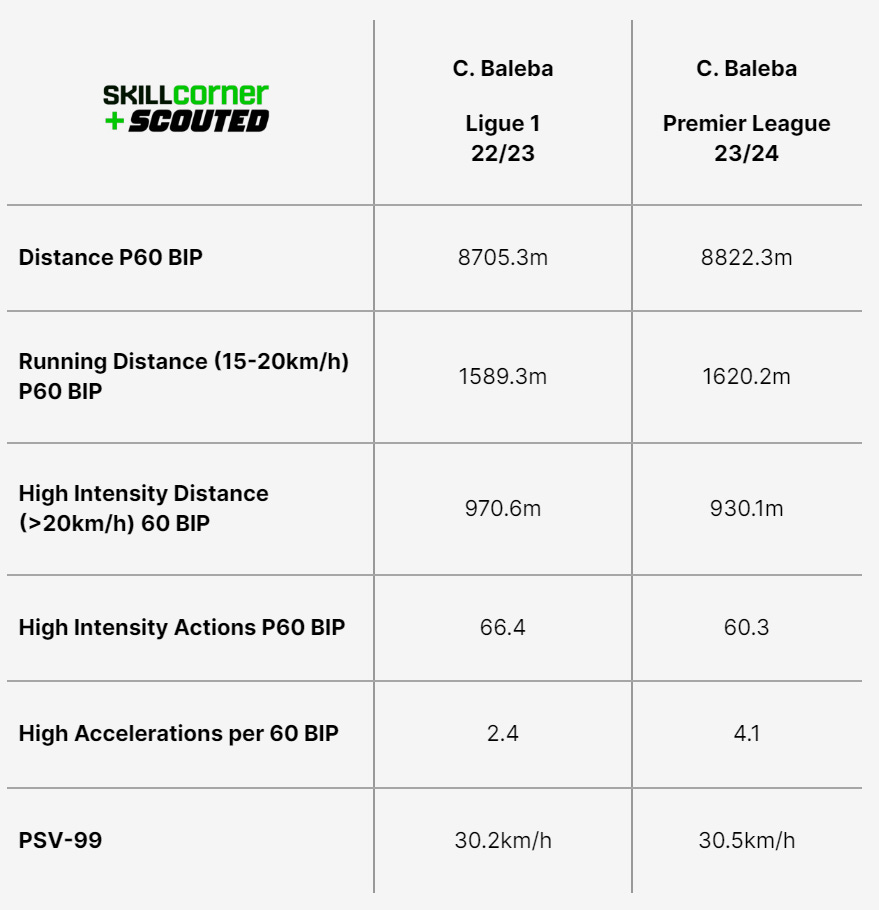
In my humble opinion, this is the most open-and-shut case of a ridiculous athletic profile translating directly into Premier League money. In this case, the money came from Brighton, a club with arguably the most effectively streamlined recruitment strategy in the Premier League.
I would not be one bit surprised if Baleba’s athletic indicators were the principal reason Brighton decided to invest in him. And if you aren’t a Baleba believer yet, I implore you to return here in 12 months time — Brighton have another good one.
INTELLIGENT ATHLETICISM
Sometimes — and especially for certain positions — it’s not good enough to be just athletic.
Let’s focus on strikers. They’re important. Not just for scoring goals, but because they generally attract the biggest fees on the transfer market.
If you can unearth a good striker, you’re in the green.
Interestingly, the efficiency of off-ball runs is another metric in which the Premier League (strikers) distances itself from Europe’s other top five leagues.
We’re going to hone in on one stat here: runs threat per 100 runs.
Threat represents the probability of the attacking team scoring a goal in the next 10 seconds if this player was to receive a pass from the player in possession.
Here are the numbers:
Now, let’s unpack why the Premier League ranks best here.
We have to start with the athletic numbers once again. Per 30 TIP — so we are measuring their output when their team has the ball — Premier League strikers are simply on another level.
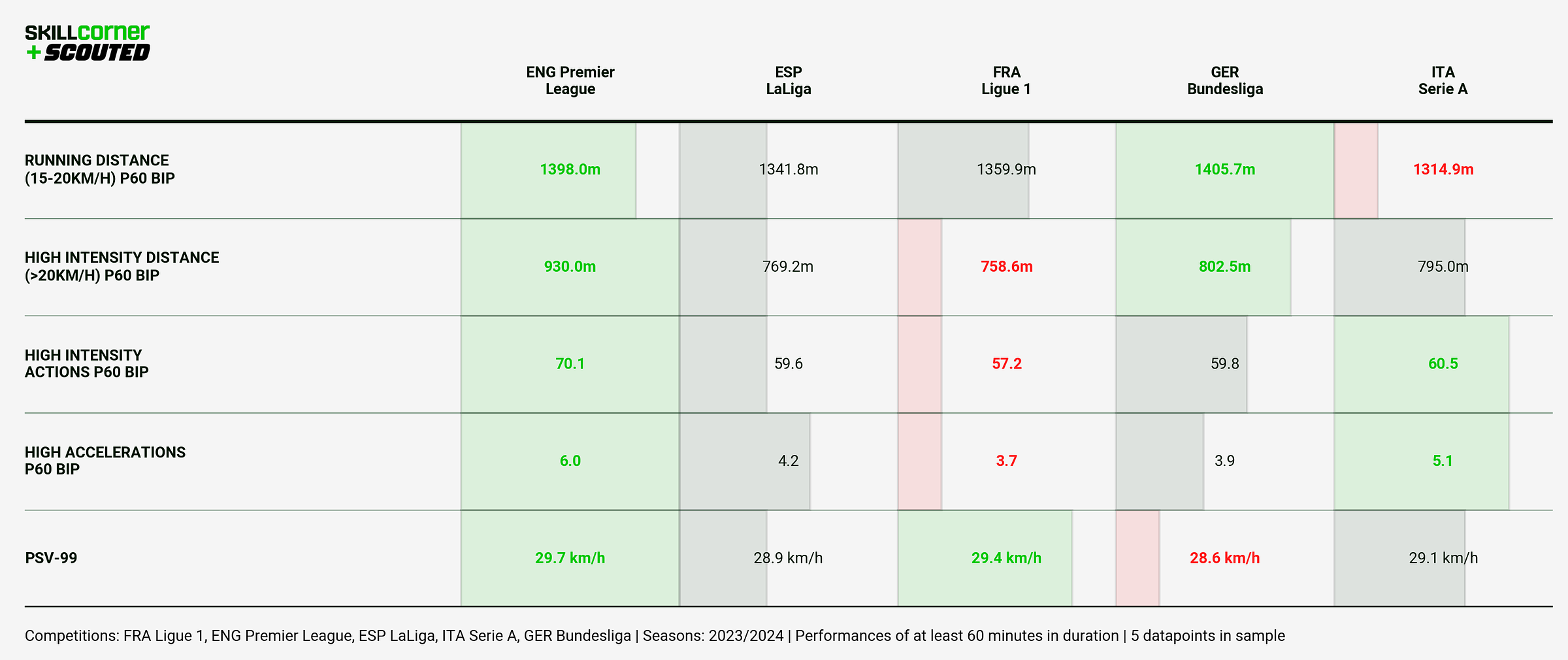
I’ve looked at the OTIP data and I can assure you this isn’t just a result of strikers saving all their energy when they don’t have the ball.
It goes without saying that there are team/position/stylistic effects on these numbers as well.
But this metric is undeniably important. Just take a look at the quality of player that ranks highly for runs threat per 100 runs in the Premier League:
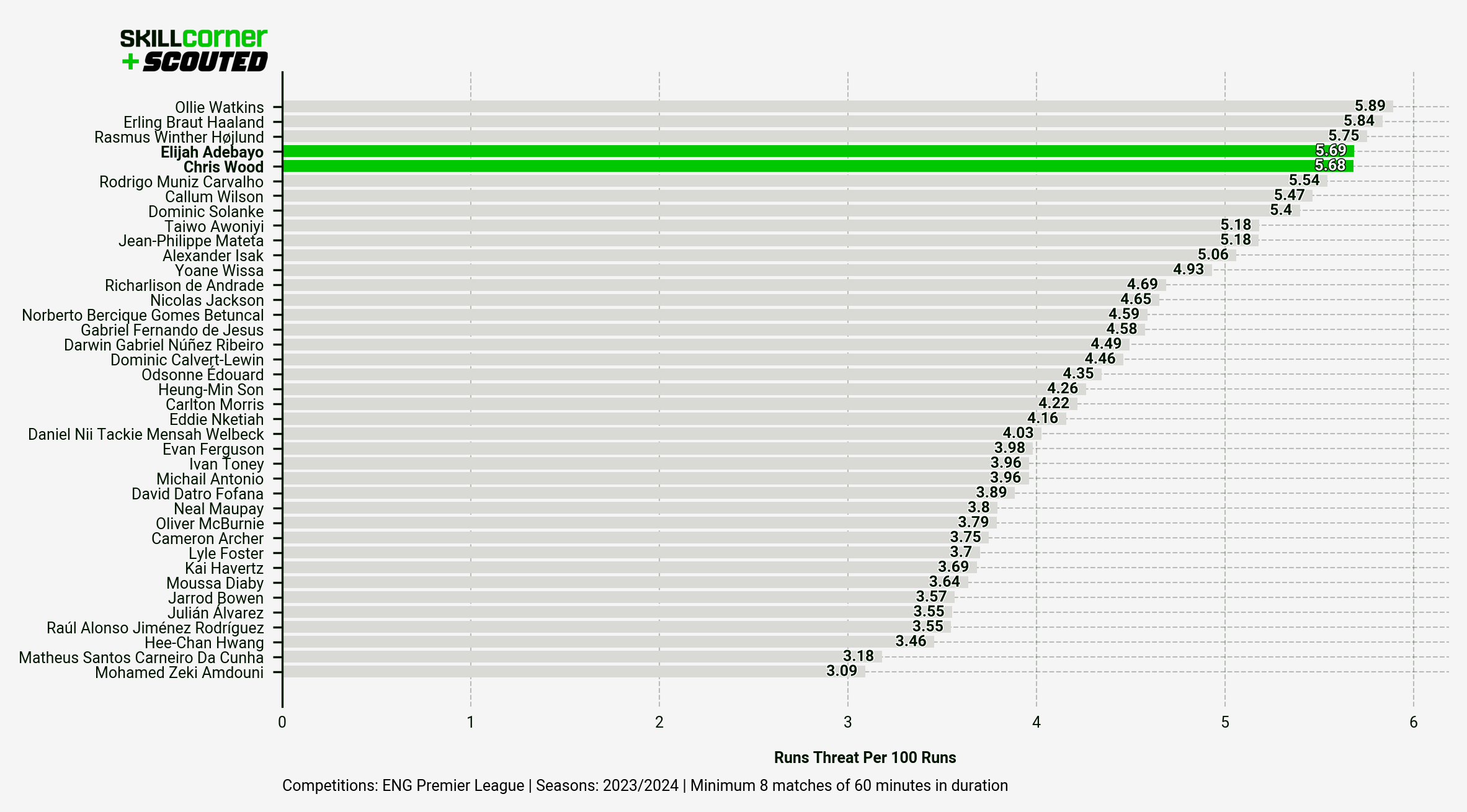
Naturally, auxiliary forwards like Zeki Amdouni and Matheus Cunha don’t rank well here. Instead, the top spots are just a collection of the Premier League’s best forwards this season. (Special shoutout to Luton’s Elijah Adebayo, who is quietly putting together a super year, and Nottingham Forest’s Chris Wood, whose excellent performance in this metric has translated to 12 non-penalty goals in under 1,600 minutes this season.)
Out of interest, let’s look at the strikers in Ligue 1 that rank above the Premier League striker average for runs threat per 100 runs.
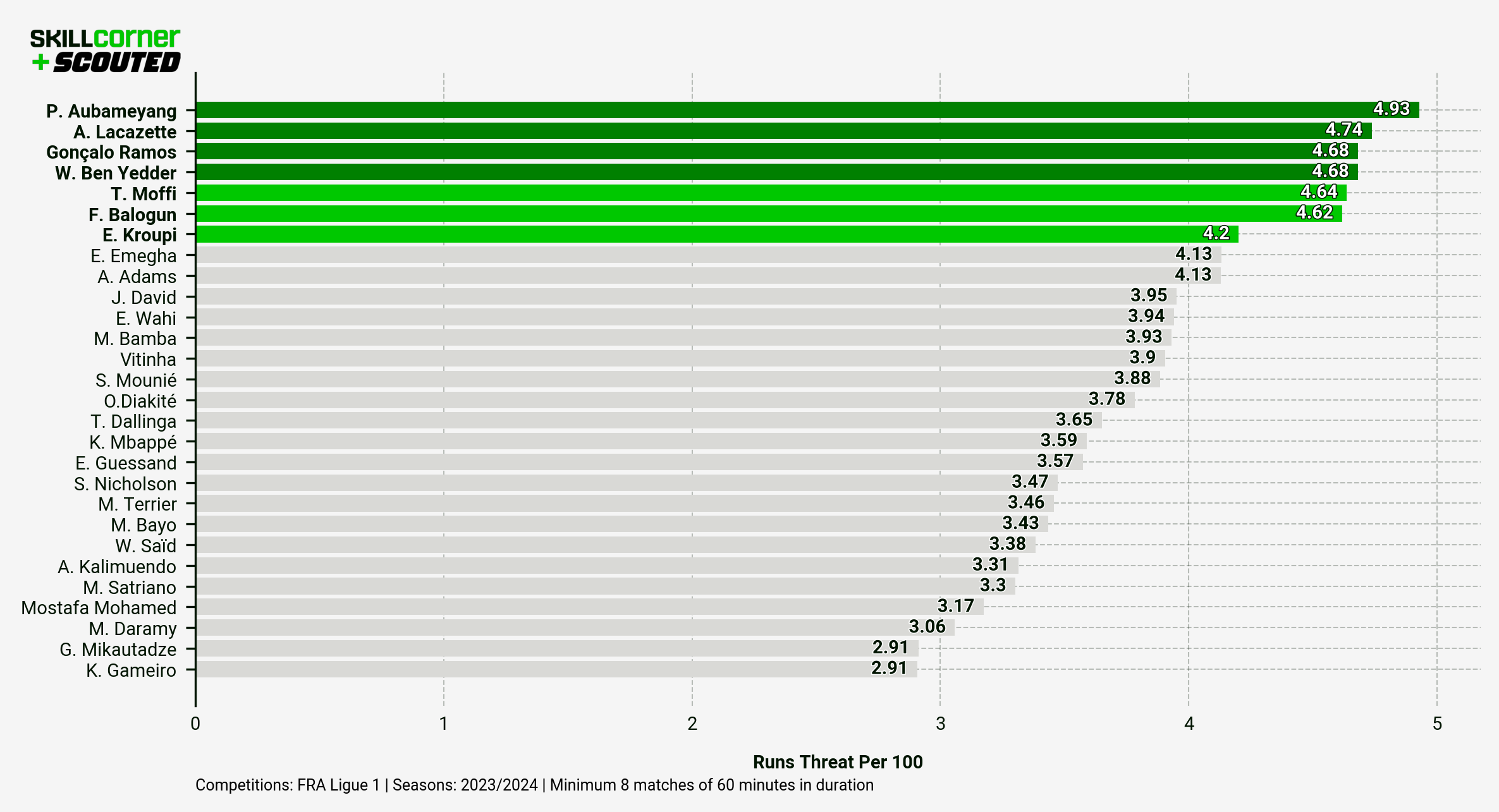
I must say I chuckled a bit when I saw two former Premier League strikers in Pierre-Emerick Aubameyang and Alexandre Lacazette in the top two positions, as well as a former Arsenal academy graduate, Folarin Balogun, at number six.
A couple of other names very much caught my attention, though: those being former Lorient and current OGC Nice striker Terem Moffi, as well as Lorient’s 17-year-old phenom Eli Junior Kroupi. Clearly, Lorient are doing something right.
Kroupi — like Doku — has an athletic profile that is far from outrageous, but shows potential as a fast-twitch mover.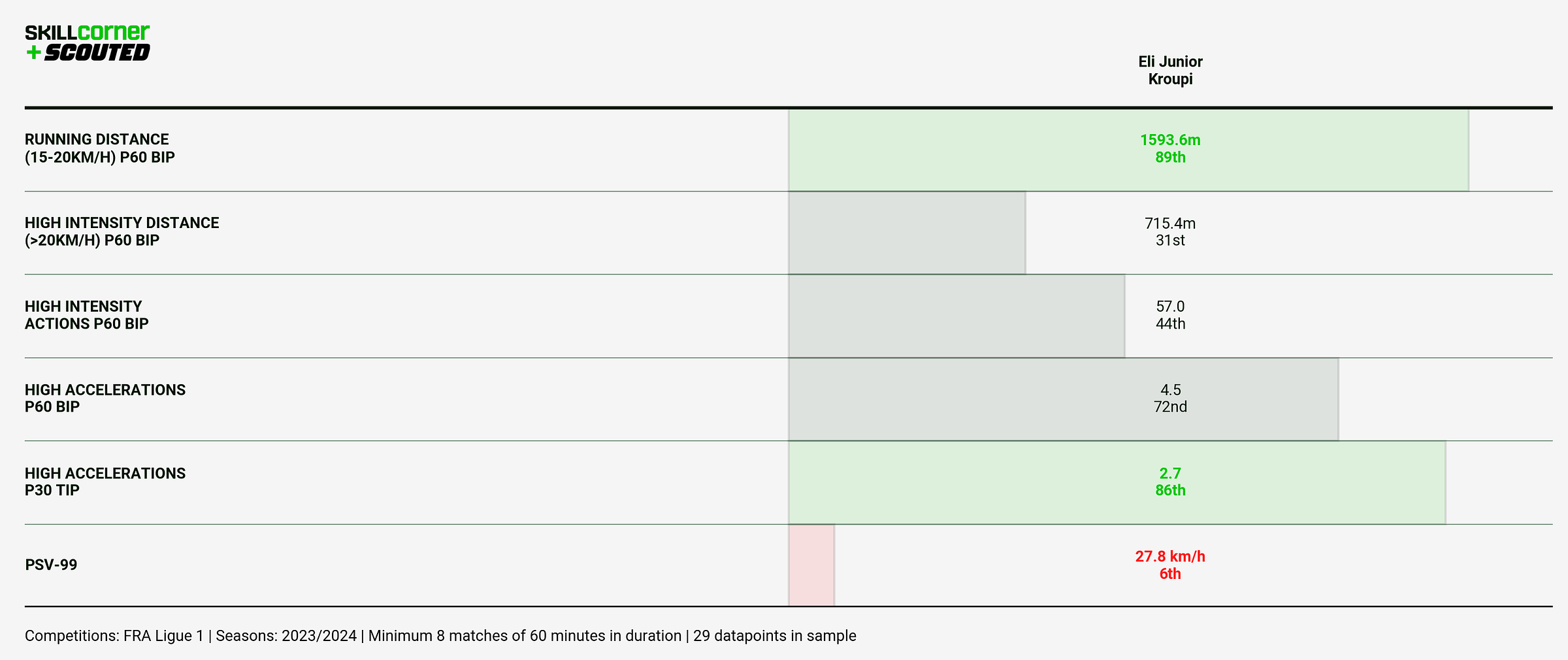
DUEL MONSTERS
Above all, the Premier League likes to recruit centre-backs from France most.
There are currently 12 French centre-backs playing in the Premier League: William Saliba, Ibrahima Konaté, Axel Disasi, Wesley Fofana, Benoît Badiashile, Raphaël Varane, Kurt Zouma, Issa Diop, Clément Lenglet, Maxime Estève, Willy Kambwala, and Malang Sarr.
Then there’s the non-French central defenders that have come directly from Ligue 1, such as Sven Botman.
For the purposes of this piece, let’s hone in on a few French defenders that have come directly from Ligue 1 in the last few years: Saliba, Disasi, Badiashile, and Estève.
The thing these players all have in common? Yep, you guessed it: monster athletic attributes to dominate games out of possession.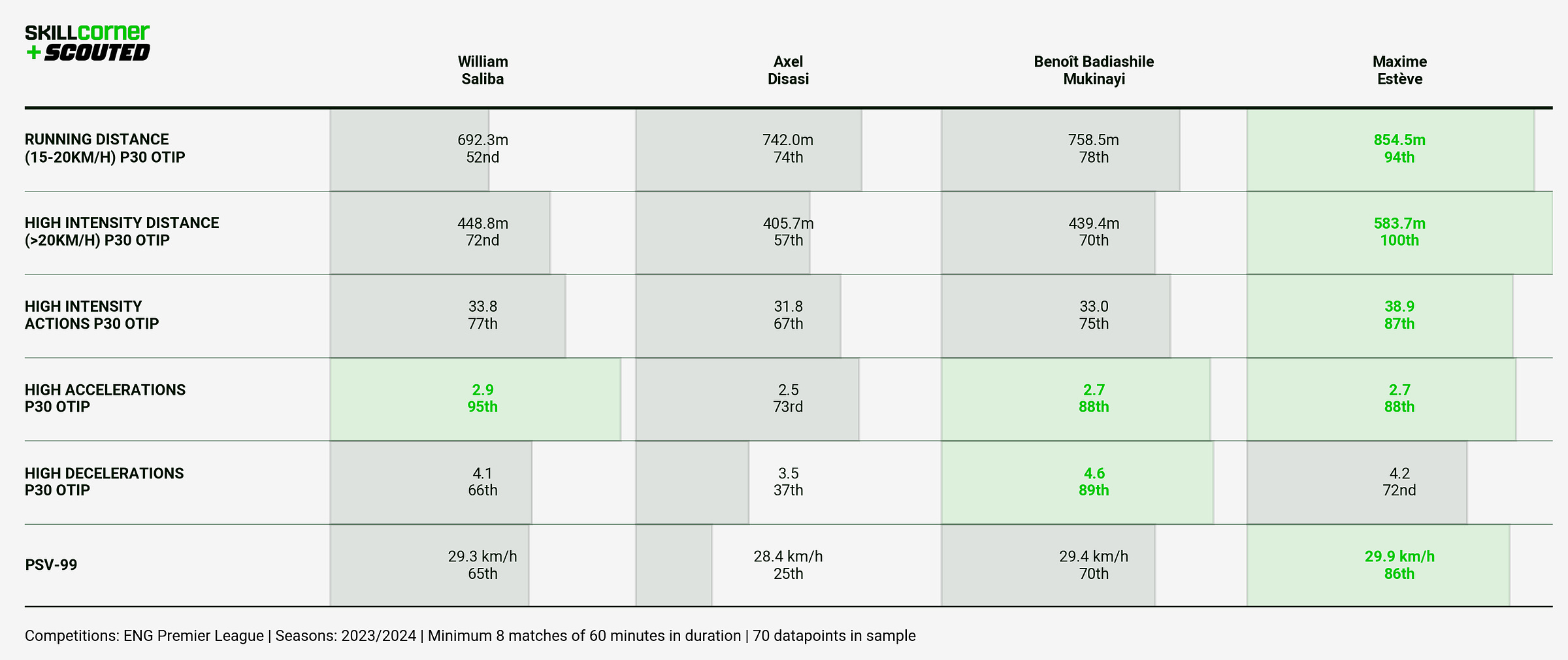
Here are some numbers to show what they do when the other team has possession, using opposition team in possession (OTIP) metrics:
If you are looking to counter the insane athleticism of Premier League attackers, your defenders have to be equally absurd. These four are all listed at over 1.9m tall on TransferMarkt.com, too.
Speed plus size equals winning duels and covering transitions. It’s genuinely that simple.
Estève’s numbers are probably a little juiced by the fast-paced nature of Vincent Kompany’s Burnley, while on the other end of the spectrum, Saliba’s are likely nerfed by the complete authority of Mikel Arteta’s Arsenal. Irrespective of those finer details, the conclusion is clear: you can play at centre-back in the Premier League only if you’re built like Optimus Prime and run like Usain Bolt.
THE UNDISPUTED HEAVYWEIGHT CHAMPION OF THE WORLD
Having looked at all these positions and players, hopefully we’ve pieced together why the Premier League is the world’s most dominant league - and the market’s most dominant buyer.
For all the beauty and madness of Serie A, La Liga, the Bundesliga - or in this instance, Ligue 1 - the Premier League adds another layer of absurd physicality and athleticism to everything.
To be a professional footballer in any top-five league, you still need certain technical fundamentals to be effective. But it’s the players that mix those fundamentals with difference-making athletic qualities that earn the gargantuan Premier League contracts.
And it’s those players - and therefore, those athletic qualities - seller clubs should be on the hunt for.
To circle back to the purpose of this piece — how Ligue 1 teams can maximise revenues from sales to the Premier League — the answer(s) has become simple:
- Identify top athletes
- Look for those crucial ‘burst’ traits: sprints, high accelerations, etc.
- Lock in on the striker market
- Be more creative with recruitment from outside Ligue 1
At the end of the day, Premier League money makes the European football economy spin. The rules are simple: you gotta figure out what the customer wants and make sure you have it in stock. ‘Cos even if they’re shouty and annoying, the customer is always right.
Written by Steven Ganavas.
Click here for more information on our football products.
Click here for more of Scouted's writing on emerging football talent.